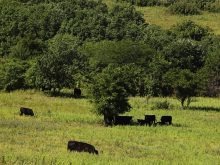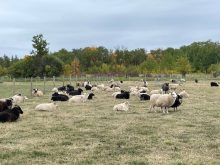Soil fertility: a simple concept that requires long and well thought out answers. There are lots of articles on soil nutrient testing, along with many procedures, methods and interpretations.
Early on in the 1970s with Alberta Agriculture, my colleagues and I were very surprised with the answers to the soil testing questions we asked. A large random number of growers replied to our questions and only around 10 per cent actually had their cropland tested for soil nutrients. In those early days it seems nitrogen (N) was really considered, phosphate (P) was sometimes looked at, and both sulphur (S) and potash (K) were essentially considered plentiful and ignored. A couple of scientists in Alberta sounded the alarm on sulphur, pointing out soil deficiencies of this nutrient in both Alberta and Saskatchewan.
In my canola crop surveys, especially on sandy or sandy loam soils, we found lots of sulphur-deficient canola crops. I was told by several soil scientists they had never recommended sulphur. They seemed to assume the sulphur pollution in Eastern Canada, Ontario in particular, applied to the west. The real answer was that in previous years in the 1960s on the Prairies, the usual nitrogen source was ammonium sulphate or ammonium phosphate, both with high S contents at 24 and 14 per cent respectively. In the early ’70s, these products were replaced by urea and ammonia as nitrogen sources, with no thought of the S requirements of all field crops, particularly canola. In Ontario in the ’70s, it was not unusual to have 30 to 50 lbs. of S fall per acre in the industrial south, whereas on the Prairies less than two pounds per acre could be expected from aerial pollution annually. Pretty soon sulphur became a key nutrient Prairie-wide.
Read Also

Gentle treatments for pain in the neck
Heading toward year-end, people unknowingly tense up against the cold and busyness, causing neck pain that can often be treated with appropriate support and gentle mobility, athletic therapist Kathlyn Hossack says.
A similar situation occurred with potash, especially in hay production. It was pointed out to producers that a four-ton crop of alfalfa could remove 175 lbs. of K per acre. In addition, the sale of baled cereal straw would remove 60-70 lbs. of potash per acre.
Soon it became obvious crop production on the originally fertile Prairies was removing major crop nutrients at an alarming rate.
In recent years (2022), according to Fertilizer Canada’s use survey, over 40 per cent of Prairie farmers sampled each canola and wheat field. The Canola Council of Canada states 40 per cent of its survey respondents test each field each year. Just over 50 per cent of high-yield growers test for nitrogen every year.
As crop yields were expected to go higher and higher, the need for crop nutrient replacement became critical. Soils 150 years ago, from Manitoba to the B.C. Peace region, were losing their nutrient-rich organic matter. Soils which, around 1900, were two, five or 10 per cent organic matter were now down to one, two or five per cent organic reserves. Remember: a one per cent soil organic matter per acre, in its top six inches (15 cm), contains 10,000 lbs. of carbon, 1,000 lbs. of nitrogen, 100 lbs. of phosphate, 100 lbs. of sulphur and one per cent or less of boron. Soil organic matter slowly releases its nutrients — that is, its “black matter,” not to be confused with crop residues. A 10 per cent soil organic matter would release 70 to 90 lbs. of nitrogen under normal Prairie growing conditions when cultivated annually, along with P, S and boron. A one per cent soil organic matter, on the other hand, would only release seven to 10 lbs. of nitrogen, along with very small amounts of P, S and boron.
In other words, if you do not replace these nutrients with the recommended amounts of N, P, K and S after an appropriate soil test, you cannot set a target yield. One pound of N is one pound of N, whether it’s applied as urea or some expensive N product.
All of the fertilizer chemicals we apply are usually in the form of concentrated plant nutrients. They are not “synthetic” — they are just concentrated from nature for convenience. Organic N, P, K and S are factually the same as “chemical” N, P, K and S. So, if your target yield for wheat is 60 bu./ac. and you need 100 lbs. of additional N following a soil test, it doesn’t matter whether the N is in chemical or an organic form (poultry manure), it has to have 100 lbs. of available N per acre.
To clarify this, read the fact sheet “Minerals for plant, animals and man” to understand soil testing and crop nutrients needed for target yields from alfalfa to wheat.
Micronutrients
Now that I’ve dealt with those four macronutrients, N, P, K and S, let’s also include calcium (Ca) or magnesium (Mg) on that list, since they are rarely if ever a nutrient problem. The exceptions for Ca and Mg are when soils are very acidic — that is, pH below 5. I will deal with both at a later time, since alfalfa should not be grown on soils below pH 6, and wheat, to optimize yield, should be grown on soils above 5.5.
Now take a long look at the plant and animal importance of micronutrients on the Alberta fact sheet I referred to earlier, which for a while was the most requested publication in Western Canada.
Copper and zinc
There seems to be an attitude, among more than a few agronomists, that talking about micronutrients is “unmacho” and those are unimportant in Prairie agriculture. How wrong can they be? You can have all of the N, P, K and S for a target yield, but if a micronutrient is missing or deficient, your expected yield could crash, resulting in low-yielding sample grain. This is well documented for copper (Cu) or zinc (Zn) deficiency, especially in wet growing seasons. Zinc deficiency may occur on beans but is much more common on corn. For example, a 100-bushel crop of corn will remove around 1 ½ ounces of zinc. A 60-bushel crop of wheat will remove almost half an ounce of copper. Every crop grown will remove both these micronutrients, so after 100 years of crop production, you will have removed perhaps 100 ounces of zinc (six pounds) and 50 ounces of copper (three pounds actual copper). The lighter sandy Prairie soils likely only had five to six pounds of zinc and maybe three to four pounds of copper in the top six inches of soil. Do the math.
There may be more zinc and copper deeper down, but that may be unavailable in wet growing years due to shallow crop rooting. Heavier clay and clay loam soils may contain higher levels of both Zn and Cu, but still the amount left in the soil can become crop-limiting.
Iron and manganese
Iron (Fe) is seldom limiting due to its abundance in most soils, but at very high pH levels (pH around 8) it may become unavailable to crops such as soybeans or corn.
Manganese (Mn) is very similar in behaviour to iron at high soil pH and especially under dry soil conditions. In southwestern Alberta in dry springs, it’s not uncommon to see manganese deficiency in both wheat and barley that may be corrected after a few inches of rainfall or a foliar application of manganese.
Molybdenum
Molybdenum (Mo) is only needed at a few grams an acre but is totally important for the nitrogen metabolism of all crop plants. This micronutrient becomes less available to unavailable at a pH below 5.
The late Phil Thomas and I solved a canola growing problem for the University of Idaho many years ago. The canola crop refused to grow past the rosette stage in one of its research fields. After very many questions and discussions, we concluded the field with a pH of 7 was devoid of available molybdenum. We were correct: a couple of ounces per acre solved the problem. Researchers in Idaho were able to show up to 25 per cent of the state was low or totally deficient in molybdenum. This could be the case on the Canadian Prairies, but no one has done the work. Crops, especially legumes (peas, alfalfa), will grow very poorly when soil levels of molybdenum are low.
In alkaline and saline soils, molybdenum levels in hay or forages grazed on such cropland may be high. Such feedstock for cattle can result in molybdenum-induced copper deficiency on molybdosis. Check with an animal nutritionist if you suspect a problem.
For producers growing crops, especially canola on acidic soils around pH 5, it would be wise to apply a few ounces of molybdenum to the cropland along with the bulk fertilizer or add to the crop seed for very little extra cost, a practice followed by several successful Prairie crop consultants.
Boron
We now know very low levels of soil-available boron (B) at around 0.1 part per million (p.p.m.) can result in ergot infection in barley and wheat due to pollen tube failure and very reduced yields. Recommended levels of boron should be in the region of 0.5 to one p.p.m.; that’s one to two pounds of actual boron per acre. Under dry soil conditions, boron is not very mobile, and it is suspected that flowering canola crops may not pick up sufficient boron. As a result of boron deficiency, many canola flowers fail to pollinate properly due to pollen tube failure, resulting in depressed yield.
Just think: when you harvest any crop, you are removing not only N, P, K and S but all the micronutrients, Mg, Zn, Cu, Fe, Mn and B, on an annual basis. You are depleting your soil reserves and any micronutrient that falls below recommended levels will lower your target yield moderately or severely, depending on any given crop and its nutrient needs.
















